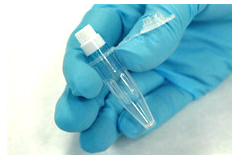Archival Notice
This is an archive page that is no longer being updated. It may contain outdated information and links may no longer function as originally intended.
Home | Glossary | Resources | Help | Contact Us | Course Map
Constructed with an open end and a woven end, spin baskets hold a cutting of substrate and are inserted into a common microcentrifuge tube. This allows for the retention of liquid carrying the biological material to be separated from the substrate during centrifugation steps. Any cells that may not be completely freed from the substrate are forced into the tube, along with the excess fluid. Spin baskets may also be used in organic extractions, although their composition prohibits immersion in phenol/chloroform/isoamyl alcohol (PCI).
For example, Promega offers the Differex™ System, which includes a proprietary separation solution and the use of a spin basket, increasing the efficiency of the traditional method of differential extraction from sperm versus non-sperm cells. The procedure begins with Proteinase K digestion to lyse non-sperm cells. The sample and buffer are placed into a spin basket within the tube containing the proprietary solution. This solution is not miscible with the aqueous buffer. Through centrifugation, the sperm cells form pellets, while the non-sperm DNA remains in solution. The difference between this system and routine differential extraction is that the separation solution acts as a selective membrane (without the risk of clogging), which is purported to reduce the chance of sperm loss. After the removal of the solution containing non-sperm DNA, the sperm DNA is isolated using the DN™ System, described later in this module.
Additional Online Courses
- What Every First Responding Officer Should Know About DNA Evidence
- Collecting DNA Evidence at Property Crime Scenes
- DNA – A Prosecutor’s Practice Notebook
- Crime Scene and DNA Basics
- Laboratory Safety Programs
- DNA Amplification
- Population Genetics and Statistics
- Non-STR DNA Markers: SNPs, Y-STRs, LCN and mtDNA
- Firearms Examiner Training
- Forensic DNA Education for Law Enforcement Decisionmakers
- What Every Investigator and Evidence Technician Should Know About DNA Evidence
- Principles of Forensic DNA for Officers of the Court
- Law 101: Legal Guide for the Forensic Expert
- Laboratory Orientation and Testing of Body Fluids and Tissues
- DNA Extraction and Quantitation
- STR Data Analysis and Interpretation
- Communication Skills, Report Writing, and Courtroom Testimony
- Español for Law Enforcement
- Amplified DNA Product Separation for Forensic Analysts


